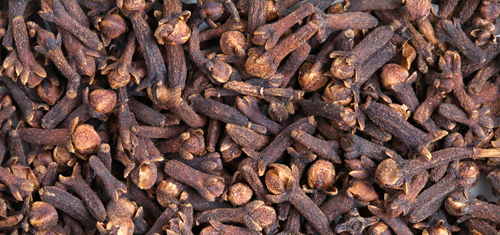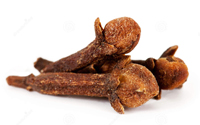Cloves
Cloves
Pronounced: kloʊv

The word ‘clove’ is from the Latin word for ‘nail’ – clavus. Cloves are native to the North Moluccas, the Spice Islands of Indonesia. It is cultivated in Brazil, the West Indies, Mauritius, Madagascar, India, Sri Lanka, Zanzibar and Pemba. The Chinese wrote of cloves as early as 400 BC. and there is a record from 200 BC of courtiers keeping cloves in their mouths to avoid offending the emperor while addressing him. Arab traders delivered cloves to the Romans.
What Is Cloves?
 Cloves are the aromatic flower buds of the tree known botanically as Syzygium aromaticum, which is synonymous with Eugenia aromaticum or Eugenia caryophyllata, in the Myrtaceae family. Cloves are the immature unopened flower buds of a tropical tree. When fresh, they are pink, dried, they turn to a rust-brown colour. Measuring 12-16 mm (1/2”-5/8”) long, they resemble small nails, with a tapered stem. The large end of the clove is the four-pointed flower bud. This tropical evergreen tree is native to the Moluccas Islands, or Spice Islands, of Indonesia. It may attain a height of 50 feet and it’s propagated by seeds planted in the shade. Trees will start flowering after the fifth year. Most of the world’s supply comes from Zanzibar, Madagascar and Brazil.
Cloves are the aromatic flower buds of the tree known botanically as Syzygium aromaticum, which is synonymous with Eugenia aromaticum or Eugenia caryophyllata, in the Myrtaceae family. Cloves are the immature unopened flower buds of a tropical tree. When fresh, they are pink, dried, they turn to a rust-brown colour. Measuring 12-16 mm (1/2”-5/8”) long, they resemble small nails, with a tapered stem. The large end of the clove is the four-pointed flower bud. This tropical evergreen tree is native to the Moluccas Islands, or Spice Islands, of Indonesia. It may attain a height of 50 feet and it’s propagated by seeds planted in the shade. Trees will start flowering after the fifth year. Most of the world’s supply comes from Zanzibar, Madagascar and Brazil.
Plant and Cultivation
The clove is an indigenous plant species of the former Spice Islands – the Molucca Islands, which are now in Indonesia as well as the southern parts of the Philippines islands. Due to the commercial value and high sale potential of this spice, large plantations devoted to cloves exist in the tropical countries such as Tanzania and Madagascar in East Africa and, this is also a plantation plant to a lesser extent in the new world tropical countries of Brazil and the West Indies in the Caribbean. Semi-ripe cutting of the plant are used in the summer to propagate the herb, while seeds are used in the spring to propagate the tree.
A conical tropical evergreen myrtaceous tree reaching heights of up to 14m (45 ft). The bark is gray, the leaves are a shiny dark green, elliptical in shape and very fragrant. Small crimson flowers grow in triple clusters at the ends of branches. The fruit is a purple drupe, about 2.5 cm (1”) long. Cloves grow in the tropics and best near the sea. Rainfall must be at least sixty inches per year and a dry season is needed for harvesting and curing. The clove clusters are picked by hand before the buds open and dried on palm mats.
Terminal flower clusters start out with a pale color that turns to green at first then bright red as the flowers form. Cloves are harvested just before the flowers mature so that the four flower petals don’t open and instead stay in little ball shapes. Some think that cloves look like little nails, so the head of the nail would be the ball of flower petals surrounded by four sepals. The young floral buds are plucked and harvested for sun drying and processing two times every year in most plantations. Cloves are harvested by hand-picking in late summer and again in winter. A single tree may yield up to 75 pounds of dried flower buds. The dried cloves are a dark reddish-brown color and they vary in size from ½ to ¾ inch long.
Description
Cloves are the unopened pink flower buds of the evergreen clove tree that are small nailed shaped flower buds that are dried. Cloves have a warm, sweet and aromatic taste that evokes the sultry tropical climates where they are grown The buds are picked by hand when they are pink and dried until they turn brown in color. Cloves are about 1/2-inch long and 1/4-inch in diameter and with their tapered stem, they resemble tiny nails. Although cloves have a very hard exterior, their flesh features an oily compound that is essential to their nutritional and flavor profile.
Cloves are native to Indonesia. Cloves are harvested mainly in Indonesia, Sri Lanka, and India. Cloves were used in the Middle Ages to preserve, flavor and garnish foods. Today, cloves are used in cooking in whole or ground form. Cloves have a very strong aroma so a little goes a long way in any recipe. Cloves are best bought whole. As a powder flavour quickly deteriorates. Being extremely hard, it is difficult to grind cloves with a mortar and pestle so an electric grinder such as a coffee grinder is recommended. Ground cloves are commonly used in baking. Store in an airtight container out of direct light.
Producing Countries of Cloves
Cloves grow in the North Moluccas (Indonesia) and this is said to be its origin. Indonesia is by far the world’s largest clove producer. The second largest producer is Madagascar (south-eastern and northern parts of the island), then follow Brazil, Tanzania (Zanzibar) and Sri Lanka. Madagascar has become the largest exporting country. Brazil occupies the second place among the producer . Zanzibar was historically the world clove leader until the Sixties. They had also been cultivated on the islands of Bacan, Ternate, Tidore, and on the West coast of Halmahera. Beyond these regions, the Dutch expanded cultivation to other locations in the Moluccas. Until the 18th century, the Dutch remained in control of clove production. When their monopoly over cloves ended, cloves were introduced in other countries. Unguja and Pemba are important clove production areas. Together, these two places form Zanzibar. The Sultanate of Zanzibar (Unguja and Pemba), which lasted from 1963–1964, even had the clove buds as a symbol on their flag. In addition to Zanzibar (Unguja and Pemba), cloves are produced on other East African islands. Madagascar is said to be a main production area of cloves. In Indonesia, clove production has increased once more since the Second World War.
Consuming Countries of Cloves
Cloves are available now in every corner of the world. Whether cloves grow in a particular region or not is not important because these spices can be transported to any part of the world. In the days of the Roman Empire, cloves were very expensive, and Arabs were the first traders that brought this wonderful spice to Europe. Cloves have properties that other spices simply do not have. In addition to the properties that are used for cooking, cloves are also used as remedies for bad breath and tooth conditions. It is because of the demand for clove treatments and its use as a spice in foods that its production has lasted and grown over the years.
Singapore is traditionally a world gravity center for clove trade. Singapore buys regularly more than 50% of the Malagasy production. Singapore is explained by the legendary know-how of its wholesale merchants and the good available storage capacities. For several years, Dubai, in the United Arab Emirates, has emerged as another great dynamic place.
Apart from Indonesia, the largest consuming markets are India (14.000 tons) and far behind, the USA (1.300 tons).
